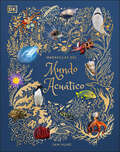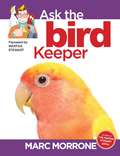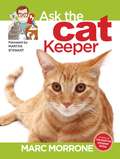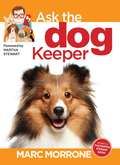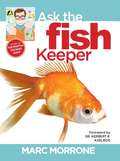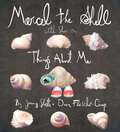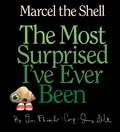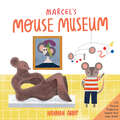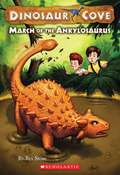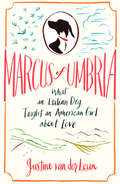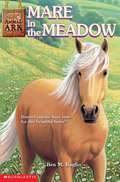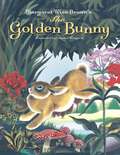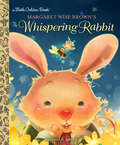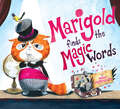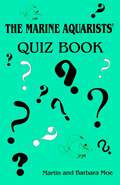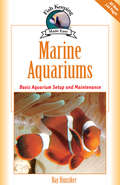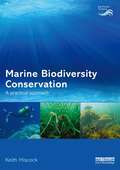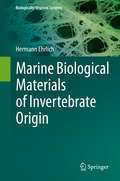- Table View
- List View
Maravillas del mundo acuático (DK Children's Anthologies)
by Sam HumeDesde el océano más ancho y profundo hasta el charco más pequeño, este hermoso álbum lleva a los niños lectores por un viaje fascinante a través del mundo acuático, en el que conocerán animales increíbles, plantas ingeniosas y mucho más. Impresionantes fotografías y hermosas ilustraciones complementan las descripciones de cada forma de vida, con las que los niños descubrirán cientos de datos interesantes mientras leen. ¿Sabías que los elefantes marinos pueden contener la respiración bajo el agua durante más de una hora, o que la planta acuática Victoria Cruiziana puede soportar el peso de un adulto, o que el reptil basílisco (teterete) puede correr sobre el agua?Descubre la ciencia de cómo las plantas han aprendido a vivir, alimentarse y respirar en el agua y echa un vistazo a los desafíos únicos de los diferentes ecosistemas, las características de los ríos, lagos, humedales y más. Contiene un índice visual lleno de información de referencia, con el tamaño y hábitat de cada especie.Con una elegante cinta marcapáginas y detalles dorados en la portada y en los bordes, 'Maravillas del mundo acuático' es un regalo atractivo para cualquier niño que le encante el mundo natural, ideal para que los más pequeños exploren por sí mismos o para leer cuentos a la hora de acostarse. Desde tiburones y peces vela hasta juncos y escarabajos, hay algo para todos en esta celebración de todas las cosas acuáticas.From the deepest, widest ocean to the tiniest puddle, this beautiful compendium takes young readers on an enthralling journey through the aquatic world, meeting amazing animals, ingenious plants, and much more along the way. Stunning photography and gorgeous illustrations complement storybook descriptions about each lifeform, and children can uncover hundreds of fascinating facts as they read. Did you know that elephant seals that can hold their breath underwater for more than an hour, or that the Victoria Amazonica water lily can support the weight of an adult, or that the brown basilisk reptile can run across water?Discover the science of how plants have learned to live, feed, and breathe in water, and take a look at the unique challenges of distinct ecosystems on feature spreads about rivers, lakes, wetlands, and more. There&’s also a visual index, packed with reference information including the size and location of each species.With foil on the cover, gilded edges, and a ribbon for keeping your place, 'Maravillas del mundo acuático' makes an attractive gift for any child who can&’t get enough of the natural world – and it&’s perfect for young readers to explore by themselves or for bedtime stories. From sharks and sailfish, to bulrushes and beetles, there&’s something for everyone in this celebration of all things aquatic.
Marc Morrone's Ask the Bird Keeper
by Marc Morrone Amy FernandezMade famous on The Martha Stewart Show on television and Sirius radio, Marc Morrone is front and center to answer his viewers' (and his readers') many questions about their favorite pets.<P><P> In Ask the Bird Keeper, Marc's quirky, entertaining personality shines on every page as he spews out his wisdom, know-how, and hilarious anecdotes to answer dozens of questions. Divided into nine chapters, this book offers answers on hundreds of topics about feeding, housing, training, healthy, anatomy, and everyday care. In the "Food" chapter-from grit to grub-Marc discusses dietary changes, supplements, people food, and different kinds of diets. A chapter devoted to accommodations talks about various cage options, choosing the right size cage and equipment, and cleaning tips. Positive reinforcement underscores Marc's chapter "School," in which he lectures on bonding, hyperactive, noise issues, and challenging bird behaviors. As a self-taught bird keeper, Marc's chapter on "Health" is a true primer in what owners can and cannot do, from first aid tips and trimming (nails, beaks, feathers) to broken tails, parasites, parrot fever and bird flu. While Marc is often laugh-out-loud funny in all of the chapters, it is his genuine admiration and respect for his avian friends that make this book a unique resource for all pet lovers. Fill with real first-hand information and reliable tips, readers will be laughing and learning in equal measure! The book is beautifully designed and illustrated with color photographs as well as original artwork by Jason O'Malley.
Marc Morrone's Ask the Cat Keeper
by Marc Morrone Amy FernandezMade famous on The Martha Stewart Show on television and Sirius radio, Marc Morrone is front and center to answer his viewers' (and his readers') many questions about their favorite pets. In Ask the Cat Keeper, Marc's quirky, entertaining personality shines on every page as he spews out his wisdom, know-how, and hilarious anecdotes to answer dozens of questions. Cat owners will learn about topics ranging from feeding and grooming to behavior and trick training. In the chapter called "Food," Marc discusses types of food, feline nutrition, fad diets, overfeeding, and fussy eaters. In "Potty," Marc covers every possible issue concerning litter-box training cats, from toxoplasmosis and toilet training to odor management for multi-cat households and males' marking indoors. Whether you're interested in vaccines, allergies, anatomy, bathing, or annoying feline behaviors, Ask the Cat Keeper covers it and much more. While Marc is often laugh-out-loud funny in all of the chapters, it is his genuine admiration and respect for felines that make this book a unique resource for all cat lovers. Fill with real first-hand information and reliable tips, readers will be laughing and learning in equal measure! The book is beautifully designed and illustrated with color photographs as well as original artwork by Jason O'Malley.
Marc Morrone's Ask the Dog Keeper
by Marc Morrone Amy FernandezMade famous on The Martha Stewart Show on television and Sirius radio, Marc Morrone is front and center to answer his viewers' (and his readers') many questions about their favorite pets. In Ask the Dog Keeper, Marc's quirky, entertaining personality shines on every page as he spews out his wisdom, know-how, and hilarious anecdotes to answer dozens of questions. In the chapter on food, Marc responds to common questions about the kinds of diet that are best, treats, overeating, fussy eaters, human foods, fasting, and others. In a chapter unceremoniously titled "Poop," Marc discusses house-training problems and difficulties commonly encountered by dog owners. In "School," Marc leads the class by teaching his readers about the easiest ways to teach the hardest commands and how to remedy challenging behavioral issues. Other topics covered in the book are health, hygiene, safety, traveling, and much more. While Marc is often laugh-out-loud funny in all of the chapters, it is his genuine admiration and respect for his canines that make this book a unique resource for all dog lovers. Fill with real first-hand information and reliable tips, readers will be laughing and learning in equal measure! The book is beautifully designed and illustrated with color photographs as well as original artwork by Jason O'Malley.
Marc Morrone's Ask the Fish Keeper
by Marc Morrone Amy FernandezMade famous on The Martha Stewart Show on television and Sirius radio, Marc Morrone is front and center to answer his viewers' (and his readers') many questions about their favorite pets. In Ask the Fish Keeper, Marc's quirky, entertaining personality shines on every page as he spews out his wisdom, know-how, and hilarious anecdotes to answer dozens of questions.Divided into ten chapters, Marc tackles a range of topics from flakes, flies, and feeder fish in the "Food" chapter and cycling, changing water, and testing in the "Water" chapter to complete chapters dedicated to fish health, care, filters, and fish behavior. For fish keepers interested in either marine or freshwater fishes, there are specific chapters dedicated to both, covering topics tank setup, equipment, parasite, and favorite species.While Marc is often laugh-out-loud funny in all of the chapters, it is his genuine admiration of all kinds of fishes and animals in general that makes this book a unique resource for all pet lovers. Fill with real first-hand information and reliable tips, readers will be laughing and learning in equal measure! The book is beautifully designed and illustrated with color photographs as well as original artwork by Jason O'Malley.
Marcel the Shell With Shoes On: Things About Me (Marcel the Shell #1)
by Jenny Slate Dean Fleischer-Camp**NOW A MAJOR MOTION PICTURE** Join little Marcel the Shell with shoes and a big heart on his first picture book adventure! From the brilliant minds of comedian and actress Jenny Slate and writer and director Dean Fleischer-Camp comes the utterly charming, impossibly small, lovable mollusk marvel.Beloved online sensation, classic picture book character and now the star of a major motion picture, Marcel is an adorable one-inch-tall shell who ekes out a colorful existence. He wears a lentil as a hat and hang-glides on a Dorito, and though he may be small, he knows he has a lot of good qualities like his pretty awesome imagination. Marcel&’s millions of fans and young readers can learn more about this adorable creature and his wonderfully peculiar world in his literary debut. &“Marcel the Shell is a mollusk on the rise.&” — People &“We basically can&’t get enough Marcel–ever.&” — Glamour &“Our favorite anthropomorphic shell.&” — Entertainment Weekly &“Delightful.&” — TIME
Marcel the Shell: The Most Surprised I've Ever Been (Marcel the Shell #2)
by Jenny Slate Dean Fleischer-CampOne thing about a new day--you really never know where it will go, even if you know where it starts.Marcel the Shell with Shoes On is walking on the blanket when he is unexpectedly launched high into the air. Tumbling through space, the bird's-eye view offers our small friend not only a glimpse of the important things in life--his beloved Nana who sleeps in a fancy French bread, a stinky shoe, and a monstrous baby--but also a much bigger picture. Sometimes the most wonderful discoveries are the ones we least expect.
Marcel's Mouse Museum
by Hannah AbboThe Marcel's Mouse Museum is home to paintings and sculptures by the most famous mice of the last one hundred years, from Parmesan Picasso to Gouda Kahlo. Take a tour of mouse art history and styles with Curator Marcel and learn about art movements and styles like Cubism, self-portraits, Pop Art, and many more that have influenced art today. And we can&’t forget the cheesy fun facts and activities that go with them! With adorable mice drawn in famous artwork and an entertaining mix of mouse humor and history facts, Marcel's Mouse Museum is both educational and fun! Plus, each artist comes with an activity to try at home, perfect for inspiring the artist in everyone. The entire experience will be un-brie-lievable!
March of the Ankylosaurus (Dinosaur Cove)
by Rex StoneWhile exploring a new area of Dinosaur Cove with the Wannasaurus, Jamie and Tom discover a baby Ankylosaurus stuck in the mud. They must help it get out of the muddy marsh--but how?
Marcia Clark: Her Private Trials and Public Triumphs
by Clifford L. LinedeckerWife. Mother. Celebrity. Crusader. Who is the real Marcia Clark? How did a sheltered, studious young woman born into a religious Jewish family become a hard-hitting prosecutor and National media star? Read about: Her early childhood in san Francisco-- and dreams of the stage. Her stormy first marriage to a high-stakes gambler whose rip-off victims included O.J. Simpson ... Her Meteoric rise from defense attorney to Special Trials Prosecutor whose high-profile cases included the Rebecca Schaeffer stalker murder trial. Her past battles with Robert Shapiro. The man who was her secret mentor. Her disastrous second marriage-- and the custody battle for their two young sons that has sparked outrage across America. Why she underwent a complete makeover for the O.J. Simpson case.
Marcus ... Super Penguin to the Rescue!: A refreshing story for boys and girls. Age 6 and up.
by A. P. HernándezMarcus is a young Emperor penguin. Like all his friends, Marcus has a very comfortable life at the South Pole. Everything is happiness and tranquility ... or is it? Read about his adventures! A moving story that teaches young readers the importance of caring for our planet and working together to meet the challenges of climate change. Containing numerous illustrations, this story will inspire children to become environmental advocates. An entertaining and educational read for the whole family! This book helps: •Encourage empathy, because children can put themselves in Marcus the Penguin’s feet, and learn to share their feelings throughout the story. •Stimulate the habit of reading through a simple story that captures readers’ attention from the very first page. •Inspire environmental action, motivating children to take measures to protect our planet. •Promote ecological awareness to understand the importance of conserving biodiversity. •Provide practical ideas on how to reduce environmental impact in everyday life, such as saving energy, reducing waste, and encouraging sustainable practices. •Empower children as agents of change, teaching them that individual involvement contributes positively to caring for the environment. What’s inside? •A fun story about a very brave penguin. •A book with beautiful illustrations that will make reading more enjoyable. •Written to develop vocabulary, this book assists language development.
Marcus of Umbria: What an Italian Dog Taught an American Girl about Love
by Justine van der LeunReaders will delight in this tale of an urbanite who leaves her magazine job to move to Collelungo, Italy, population: 200. There, in the ancient city center of a historic Umbrian village, she sets up house with the enticing local gardener she met on vacation only weeks earlier. This impulsive decision launches an eye-opening series of misadventures when village life and romance turn out to be radically different from what she had imagined.Love lost with the gardener is found instead with Marcus, an abandoned English pointer that she rescues. With Marcus by her side, Justine discovers the bliss and hardship of living in the countryside: herding sheep, tending to wild horses, picking olives with her adopted Italian family, and trying her best to learn the regional dialect. The result is a rich, comic, and unconventional portrait about learning to live and love in the most unexpected ways.
Mare in the Meadow (Animal Ark #31)
by Ben M. BaglioMandy and James are having trouble finding enough time to give Chamomile -- a mare whose owner has left the country -- all the attention and exercise she needs.
Margaret Wise Brown's The Golden Bunny
by Margaret Wise BrownA beautiful gift edition of Margaret Wise Brown's classic! This wonderful collection of bunny stories and poems, by the author of Goodnight Moon, has been reissued for a new generation in a beautiful hardcover edition. Margaret Wise Brown&’s witty writing, featuring bunnies in all seasons, is brought to life with lush, ornamental paintings by Caldecott Medalist Leonard Weisgard. This deluxe picture book will be a special Easter gift for a child, or any fan of Margaret Wise Brown and Leonard Weisgard.
Margaret Wise Brown's The Whispering Rabbit (Little Golden Book)
by Margaret Wise BrownA bunny-rific bedtime story from the author of Goodnight Moon!Margaret Wise Brown's sweet, poetic tale about a little bunny and why he has to whisper was origininally published in the classic Golden Book The Golden Sleepy Book. Now newly illustrated in dreamy, seasonal pastels, this story is being reissued to delight the next generation of Little Golden Books fans.
Margaret and Midnight: Run the Race
by Valerie BoeverMargaret and Midnight: Run the Race, tells the story of a young girl growing up in Alaska with her new puppy, who instantly becomes her best friend, and their many adventures that follow. It is a story about love, devotion, hard work, family, and goals. All these make life worth living and make our futures bright and beautiful.
Margaret and Midnight: The Alaska Malamute
by Valerie BoeverMargaret and Midnight: The Alaska Malamute, fashioned after a real young lady and personal friend. Alaska is a wonderful place for a young girl and her dog to live. Margaret and Midnight grow to be the best of friends while learning lessons in life.
Margaret, Midnight, and the Alaskan Sled Dog Musher: The Alaskan Sled Dog Musher
by Valerie BoeverMargaret, Midnight, and the Alaskan Sled Dog Musher present a delightful tale for anyone who has ever had a dog for a best friend.
Mariel of Redwall (Redwall, Book #4)
by Brian JacquesMariel of Redwall is a captivating and magical adventure story in the Redwall series by Brian Jacques. At times gentle, but mostly packed with adventure and heroism on the grandest of scales, this tale is at once delightful and devastating in its proportions. Jacques weaves his customary magic, taking the reader to the heart and soul of the mythical Redwall--welcoming, terrifying, magical, and at times all too real. The place, the characters, and the adventure spring to life in a bout of indefinable magic, mystery, and mayhem. An excellent book that will leave readers begging for more. (Fortunately, there's plenty more where this came from!)
Marigold Bakes a Cake
by Mike MalbroughFor fans of Mo Willems' Don't Let the Pigeon... series. Baking the perfect cake is how Marigold spends Mondays. Being messy, noisy, and disruptive in Marigold's kitchen are how one finch, two pigeons, and three loons spend their Mondays!Marigold the cat loves Mondays, for that is when he bakes cakes! With his favorite recipe in front of him, he rolls up his sleeves and gets down to it. He whips up egg whites . . . Easy. He adds a cup of milk . . . Peasy. Then he sprinkles in just a pinch of . . . of finch?! That's not right at all! Neither are the smidgeons of pigeons or the spoonsfull of loons. Clearly a chase is in order! Yet all that leads to is a spectacularly messy kitchen. And no cake.With a recipe comprised of equal parts humor and charm, author-illustrator Mike Malbrough has cooked up a scrumptious laugh-out-loud addition to the great tradition of interruption books. Perfect for fans of Mo Willems' Don't Let the Pigeon Drive the Bus and David Ezra Stein's Interrupting Chicken.Praise for Marigold Bakes a Cake"This book contains the perfect recipe for fun. The watercolor illustrations are impeccable. . . This humorous book would be ideal for a storytime reading."--School Library Journal"Malbrough&’s watercolor illustrations are full of charmingly zany details, from dapper Marigold&’s polka-dot bow tie to the chocolate splatters after the birds take over the cake making, and the creatures&’ over-the-top facial expressions amp up the comedy. Playful rhymes and surprising page turns make this a great pick for a group storytime, and the comical ending . . . will be a valuable one for kiddos."--Booklist"Debut talent Malbrough celebrates the act of culinary creation and the joy of being absorbed in a personal passion—and, like the best desserts, he doesn&’t let his story get too sweet. In one of many lovely watercolor spreads, Marigold blends glossy curls of shaved chocolate and a ribbon of molasses into the batter. . . Doing what one loves, Malbrough shows, makes it possible to transcend even the basest instincts."--Publishers Weekly"Clever text follows the illustrations around the page, swirling with chocolate shavings and molasses as Marigold mixes his batter. The lush, textured watercolors match the energy of the story . . . Kids will giggle over the antics of both cat and birds during readalouds and will find plenty of humorous details to discover in the illustrations on their own."--BCCB
Marigold Finds the Magic Words
by Mike MalbroughIn his second starring role, Marigold, the fussy cat with a comically short fuse, sees his birthday party upended by a group of party-crashing birds, with hilarious results -- and a lesson in "please" and "thank you." For fans of the Don't Let the Pigeon series!Marigold is throwing himself the most amazing birthday party ever! He's baked himself an enormous birthday cake and planned everything well in advance. Everyone is ready for something extraordinary. Something...magical!But when Marigold tries to make a bouquet of flowers disappear, a pesky finch appears in its place. That's not right at all! At every turn, Marigold's magic trick gets derailed until the distractions are too much to bear, and Marigold launches into a full-on feline frenzy, making everything--and everyone--disappear. What magic words can save the day?Mike Malbrough has conjured yet another magical addition to the great tradition of interruption books. Perfect for fans of Mo Willems' Don't Let the Pigeon Drive the Bus and David Ezra Stein's Interrupting Chicken.
Marine Aquarists' Quiz Book
by Barbara Moe Martin A. MoeMartin and Barbara Moe have created the ultimate marine aquarium quiz book. There are 400 questions: each has four possible answers that test your knowledge, tease your brain, and tickle your funny bone. The correct answers are on the reverse of each question page and they are loaded with information on marine fish, marine invertebrates, marine aquaristics, reef and sea - answers that teach you a lot about this fascinating hobby. Although there isn't a million dollar prize, you could use this book to play "Who wants to be a Marine Biologist" or "Marine Aquarists trivia". Whether it is read as a source of information on the hobby or used as an entertaining exercise, it will leave you with a greater understanding of the reef, the sea, and the captive marine environment.
Marine Aquariums: Basic Aquarium Setup And Maintenance
by Ray HunzikerAuthor Ray Hunziker, longtime editor of Tropical Fish Hobbyist magazine and lifelong fish keeper, is the ideal tutor for aquarists looking to take a dive into the saltwater end of the tank!<P><P> Marine Aquariums begins with a discussion of seawater and water quality, the most critical part of keeping marine fishes happily swimming (and breathing) in their tank. Hunziker continues with a step-by-step explanation of setting up a marine aquarium, discussing aquarium types, the number of fishes for the size tank selected, siting the tank, stands, substrates, temperature, lighting, filtration and décor.The chapter on stocking and maintaining the tank discussing purchasing healthy, vibrant fish, acclimatizing them to the tank, feeding them, and monitoring the tank on a regular basis. An elaborate chapter on the various types of saltwater fishes available, "Ideal Fish for Your Marine Aquarium, "details and illustrates nearly 70 fishes divided into the following categories: moray eels, squirrelfish and soldierfish, lion fish, groupers, cardinalfish, butterflyfish, angelfish, damselfish, hawkfish, wrasses, jawfish, gobies, surgeonfish, and triggerfish. The final chapter discusses keeping fish healthy, including the signs of illness, treating various ailments, and setting up a quarantine tank for affected fish. Resources, glossary, index included.
Marine Biodiversity Conservation: A Practical Approach (Earthscan Oceans)
by Keith HiscockEffective marine biodiversity conservation is dependent upon a clear scientific rationale for practical interventions. This book is intended to provide knowledge and tools for marine conservation practitioners and to identify issues and mechanisms for upper-level undergraduate and Masters students. It also provides sound guidance for marine biology field course work and professionals. The main focus is on benthic species living on or in the seabed and immediately above, rather than on commercial fisheries or highly mobile vertebrates. Such species, including algae and invertebrates, are fundamental to a stable and sustainable marine ecosystem. The book is a practical guide based on a clear exposition of the principles of marine ecology and species biology to demonstrate how marine conservation issues and mechanisms have been tackled worldwide and especially the criteria, structures and decision trees that practitioners and managers will find useful. Well illustrated with conceptual diagrams and flow charts, the book includes case study examples from both temperate and tropical marine environments.
Marine Biological Materials of Invertebrate Origin: Invertebrates (Biologically-Inspired Systems #13)
by Hermann EhrlichThe work is a source of modern knowledge on biomineralization, biomimetics and bioinspired materials science with respect to marine invertebrates. The author gives the most coherent analysis of the nature, origin and evolution of biocomposites and biopolymers isolated from and observed in the broad diversity of marine invertebrate organisms and within their unusual structural formations. The basic format is that of a major review article, with liberal use of references to original literature. There is a wealth of new and newly synthesized information, including dozens of previously unpublished images of unique marine creatures and structures from nano- to microscale including high-resolution scanning and transmission electron micrographs. The material is organized effectively along both biological (phyla) and functional lines. The classification of biological materials of marine origin is proposed and discussed. Much of the pertinent data is organized into tables, and extensive use is made of electron micrographs and line drawings. Several modern topics e.g. “biomineralization- demineralization-remineralization phenomena”, or “phenomenon of multiphase biomineralization”, are discussed in details. Traditionally, such current concepts as hierarchical organization of biocomposites and skeletal structures, structural bioscaffolds, biosculpturing, biomimetism and bioinspiration as tools for the design of innovative materials are critically analyzed from both biological and materials science point of view using numerous unique examples of marine origin. This monograph reviews the most relevant advances in the marine biomaterials research field, pointing out several approaches being introduced and explored by distinct laboratories.
